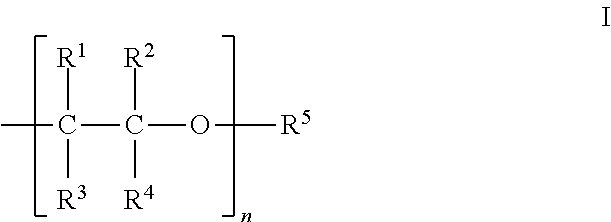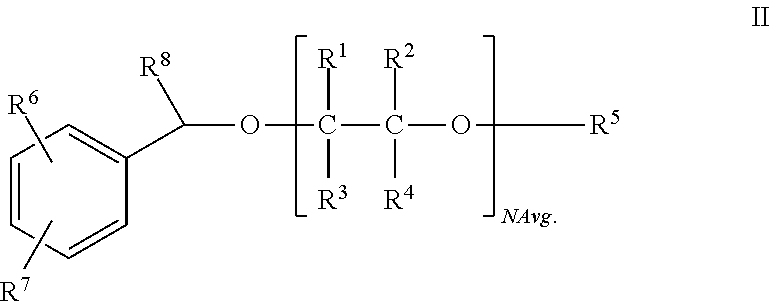Low-foaming, acidic low-temperature cleaner and process for cleaning surfaces
a low-temperature cleaner and acidic technology, applied in the field of low-foaming industrial cleaning compositions, can solve the problems of difficult control of etch rate and bath parameters, residue left behind on the cleaned surface, and difficulty in cleaning surface phosphates are forbidden or severely limited, and achieve the effect of less polluting
- Summary
- Abstract
- Description
- Claims
- Application Information
AI Technical Summary
Benefits of technology
Problems solved by technology
Method used
Image
Examples
example 1
[0072]A series of commercially available cleaners as well as certain surfactants and related compounds in water, alone, without a builder matrix were tested for cleaning performance. The cleaning effectiveness of each cleaner composition was tested follows:[0073]1. Soiled aluminum panels, 1″×4″, were used as the test specimens. Panels were run in triplicate at 120° F., 90 Seconds Exposure.[0074]2. Mineral oil and corn oil, each modified by the addition of 10% graphite, were used as the soils for each screening. Soil patches on the aluminum were deposited immediately before testing.
[0075]The test specimens were cleaned by low-impingement, continuously circulated aqueous working baths to determine chemical cleaning strength. The test also screened for foaminess. The continuous circulation promoted foam formation. Cleaning effectiveness was evaluated gravimetrically and the percentage of oily contaminant removed by the formulation was calculated by comparing soil weights before and aft...
example 2
[0090]New formulations were prepared and tested for cleaning performance according to the procedure of Example 1.
[0091]
TABLE 6IngredientABCDEFGHWater892.7885.7888.0870.0872.2868.3870870Citric Acid55.055.055.055.055.055.055.0Itaconic acid51.145% KOH33.533.533.533.533.533.533.533.5Naxonate SC1717171717Reservol P17Na bisulfite0.80.80.80.80.80.80.80.8Surfactant #96.06.03.0Surfactant #112.0Surfactant #72.0Surfactant #1212.0Surfactant #1320.0Glycerin, 96%20.013.5Surfactant #145Surfactant #151.5
[0092]
TABLE 7% Reduction at 120° F.ABCDEFGHSubstrateSoil2%,2%2%2%2%2%2%2%Aluminum-1Min Oil96.7%100.0%96.1%98.9%83.0%97.0%68.4%72.2%Aluminum-2Min Oil95.096.090.4100.087.596.878.386.6Aluminum-3Min Oil93.398.192.998.981.594.981.091.3Aluminum-1Corn Oil74.857.339.695.470.260.276.246.5Aluminum-2Corn Oil73.650.037.889.669.661.776.365.5Aluminum-3Corn Oil64.359.862.488.769.461.883.668.7
[0093]Formula A was very foamy at 2% and 120° F.
[0094]Formula B displays a significant reduction in the power to clean corn ...
example 3
[0111]New formulations were prepared and tested for cleaning performance according to the procedure of Example 1.
[0112]
TABLE 9IngredientIJKLMNWater870880885893.7900.7937.9Citric Acid55.055.055.055.055.027.545% KOH33.533.533.533.516.828% NH4OH33.5Naxonate SC17.017.017.05.010.05.0Reservol PNa bisulfite0.80.80.80.80.80.8Surfactant #1210Surfactant #132010510.010.0Glycerin, 96%2.02.0
[0113]
TABLE 10% Reduction at 120° F.IJKLMNSubstrateSoil2%,2%2%2%2%2%,Aluminum-1Min Oil96.1%100.0%100.0%100.0%53.8%100.0%Aluminum-2Min Oil95.1100.0100.0100.056.999.0Aluminum-3Min Oil98.196.1100.0100.060.4100.0Aluminum-1Corn Oil84.887.482.0100.047.787.8Aluminum-2Corn Oil84.690.777.798.156.393.1Aluminum-3Corn Oil67.288.271.196.655.287.1
[0114]The neutralizing agent was changed from potassium hydroxide to ammonium hydroxide in Formula D to generate Formula I. This formula also had a very high cloud point (over 140° F.) and the foaming in the test rig was about equal to the very low foam levels for Formula D. The f...
PUM
| Property | Measurement | Unit |
|---|---|---|
| temperature | aaaaa | aaaaa |
| time | aaaaa | aaaaa |
| temperature | aaaaa | aaaaa |
Abstract
Description
Claims
Application Information
 Login to View More
Login to View More - R&D
- Intellectual Property
- Life Sciences
- Materials
- Tech Scout
- Unparalleled Data Quality
- Higher Quality Content
- 60% Fewer Hallucinations
Browse by: Latest US Patents, China's latest patents, Technical Efficacy Thesaurus, Application Domain, Technology Topic, Popular Technical Reports.
© 2025 PatSnap. All rights reserved.Legal|Privacy policy|Modern Slavery Act Transparency Statement|Sitemap|About US| Contact US: help@patsnap.com



